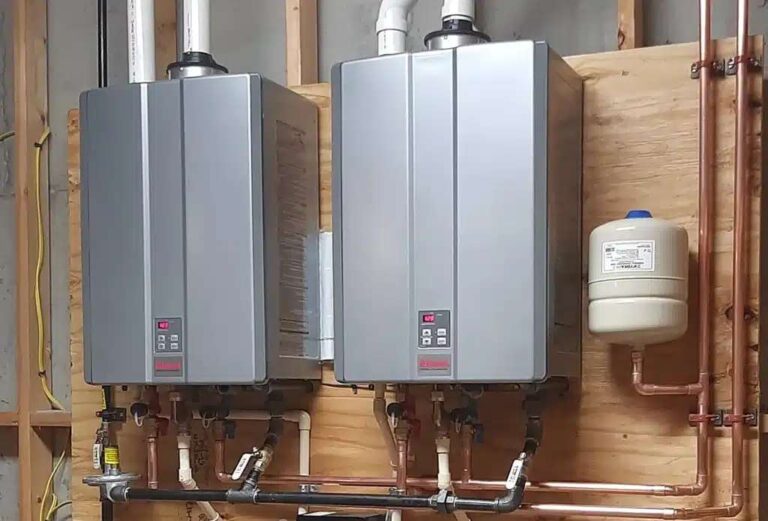Nothing ruins a morning faster than jumping on the shower floor and getting hit with ice-cold water.
Instant water heaters are supposed to give us hot water on demand, but when they act up, they can leave us shivering and frustrated.
The good news? You don’t need to empty your wallet calling a repair person for every little hiccup.
Many common tankless water heater problems have simple fixes you can handle yourself without any fancy tools or expertise.
I’ve seen so many homeowners panic at the first sign of water heater trouble.
Take a deep breath! This guide will walk you through eight budget-friendly ways to troubleshoot your instant water heater before spending big bucks on a replacement or repair service.
8 Budget-Friendly Fixes For Instant Water Heater Issues
Most water heater problems come down to a handful of usual suspects: mineral buildup, power issues, faulty parts, or incorrect settings.
The beauty of instant water heaters is that they have fewer components than traditional tank models, which often makes DIY repairs more straightforward.
Before you do anything, grab your water heater’s manual.
Don’t have it? No problem.
Most manufacturers put their manuals online—just search for your model number.
Having the manual handy can save you tons of time figuring out where parts are located and the specific maintenance requirements for your unit.
Now let’s dive into those money-saving fixes.
Reset the Water Heater
You know how sometimes your computer acts weird until you restart it? Water heaters can be similar.
A simple reset can fix various glitches from overheating to random shutdowns.
Look for a red reset button on your unit.
It’s usually near the thermostat or heating element.
If your heater has been tripping frequently, it might be telling you something’s wrong—like excess pressure or a failing part. But often, a one-time trip just needs a reset to get things flowing again.
Before pressing that button, turn off power to the unit at your breaker box.
Wait about 30 seconds, then press and hold the reset button.
Turn the power back on, and with any luck, you’ll have hot water again within minutes.
This zero-cost fix works surprisingly often.
Just don’t get into a habit of resetting constantly—that’s your heater waving a red flag about a bigger problem.
Check Power and Circuit Connections
No heat often means no power.
Sounds obvious, but many service calls end with the discovery that a breaker tripped or a connection came loose.
First step: check your home’s breaker panel.
Look for any tripped switches related to your water heater.
Flip it all the way off, then back on.
While you’re at the panel, make sure the breaker itself isn’t warm or making buzzing sounds—that could signal an electrical issue needing attention.
Next, inspect any visible wiring connected to your heater for damage, burn marks, or loose connections.
If your unit has a plug, make sure it’s securely in the outlet.
Some tankless heaters also have their own internal fuses.
Your manual will show where to find and check these.
Replacement fuses cost just a few dollars compared to a full service call.
Remember, water and electricity don’t mix.
If you notice water near any electrical components, shut everything down and skip to Calling a professional for tankless water heater repair.
Clean Mineral Sediment Buildup
Hard water is the silent killer of water heaters.
Those minerals in your water—mainly calcium and magnesium—build up inside your unit over time, blocking heat transfer and causing all sorts of problems.
Flushing your water heater might sound fancy, but it’s pretty simple.
You’ll need white vinegar, a small pump (you can rent one), and some basic hoses.
The process involves circulating vinegar through your system to dissolve those mineral deposits.
First, turn off the power and water supply to your heater.
Connect your hoses to the cold water inlet and hot water outlet service ports (they look like small valves).
Place the other ends of the hoses into a bucket with about a gallon of white vinegar. The pump will push the vinegar through your heater, dissolving the buildup.
Let it circulate for about 45 minutes, then flush with clean water until all vinegar smell is gone. This $15 solution can restore your heater’s efficiency and extend its life by years.
Do this every 6-12 months depending on your water hardness.
If you live in an area with really hard water, consider installing a water softener upstream of your water heater—it’ll pay for itself by protecting all your plumbing.
Replace Faulty Heating Element
When your water stays cold despite everything else working, a burned-out heating element is often the culprit.
Testing for this is pretty straightforward with a multimeter.
Turn off power to the unit, remove the access panel, and test the element for continuity.
No continuity means a dead element that needs replacing.
Replacement elements typically cost between $20-40. Make sure to match your old element’s specifications exactly—wattage, voltage, and physical size all matter.
The swap itself is usually just a matter of disconnecting wires, unscrewing the old element, and installing the new one in reverse order.
Take a photo of the wiring before disconnecting anything—this simple step has saved me countless headaches when reassembling things.
Also, apply some plumber’s tape to the threads of the new element before installation to prevent leaks.
This repair typically takes about an hour and saves you around $150 compared to a service call.
Just be sure you’ve completely drained and depressurized the system before removing any parts.
Fix Water Pressure Problems
Low water pressure from your instant heater can make showers disappointing and fill bathtubs at a snail’s pace.
First, check if the problem affects all fixtures or just ones connected to the water heater.
If it’s everything, your home’s main water pressure could be the issue. If it’s just hot water, look at your heater.
Many tankless units have inlet filters that catch debris.
These can clog over time. Find the cold water inlet on your unit, shut off the water supply, and unscrew the filter screen.
It might be gunked up with sediment or mineral buildup.
A good rinse under running water or soaking it in vinegar usually clears it right up.
Also check that your unit is sized correctly for your needs.
Tankless heaters have flow limitations—try to use too many hot water fixtures at once, and pressure drops. Simple solution? Stagger your hot water usage.
Run the dishwasher after showers are done, not during.
These pressure fixes cost nothing but a little time and can make a huge difference in performance.
Adjust Temperature Settings
Sometimes the fix is as simple as pushing a few buttons.
Many water heater issues stem from incorrect temperature settings.
Most manufacturers set units at 120°F, but sometimes these get changed accidentally.
If your water feels lukewarm, check your temperature setting and bump it up slightly.
Each increase of 10°F will use 3-5% more energy, so find your comfort sweet spot without going overboard.
On the flip side, if your unit keeps shutting down, it might be overheating from a temperature set too high. Try dialing it back 5-10 degrees.
Many modern tankless heaters also have economy modes that can reduce performance.
These are great for saving money but might not deliver enough hot water for a house full of teenagers taking back-to-back showers.
Play with these settings until you find your perfect balance of comfort and efficiency.
It costs nothing but can solve temperature swing issues that many people mistakenly call a repair tech to fix.
Inspect and Seal Pipe Leaks
Water leaks around your heater not only waste water but can damage your home and reduce efficiency.
Finding and fixing small leaks early can prevent bigger headaches later.
Check all visible pipes and connections around your water heater for moisture, water stains, or mineral deposits (white crusty stuff)—all signs of a leak.
Pay special attention to threaded connections, which are common leak points.
For minor leaks at threaded joints, draining and drying the area, then applying plumber’s tape and tightening the connection often solves the problem.
This tape costs about $2 and can prevent hundreds in water damage.
For pinhole leaks in pipes, temporary pipe repair clamps cost under $10 and buy you time until a permanent repair can be made.
Self-fusing silicone tape is another great temporary fix that can handle the pressure and heat of water heater lines.
Just remember that any leak repair on the water heater itself might be temporary.
If you spot actual cracks or severe corrosion on the unit’s body, start saving for a replacement.
Replace Faulty Thermostat or Temperature Sensor
If your heater runs too hot, too cold, or keeps shutting off, the thermostat or temperature sensor might be the problem.
Testing a thermostat requires a multimeter and some basic knowledge of electrical testing.
If you’re comfortable with that, shut off power, remove access panels, and test for continuity across the thermostat terminals.
Your manual will list the correct resistance readings at different temperatures.
Replacement thermostats run $20-60 depending on your model, and the swap is usually straightforward—disconnect wires from the old one, remove it, and install the new one in the same position with the same wire connections.
Temperature sensors work similarly.
They’re usually small probes that insert into the water path, and they tell the control board what temperature the water is. When they fail, your heater gets confused about water temperature.
This repair saves around $200 compared to a service call and typically takes less than an hour once you have the part.
Just be absolutely certain you’ve identified the correct component before ordering replacements.
Conclusion
Water heater troubles don’t automatically mean a huge repair bill or a new unit.
These eight fixes handle most common instant water heater problems, saving you money and extending your unit’s life.
Start with the simplest fix first—often a reset or adjusting settings solves the problem without any parts or special tools.
Work your way through more involved fixes only if needed.
Keep in mind that regular maintenance prevents many issues from happening in the first place.
Flushing your system yearly and checking connections every few months catches small problems before they become big ones.
And remember, while DIY repairs are great for your wallet, some situations call for professional help.
Electrical issues beyond basic connections, gas line problems on gas models, or any repair where you feel uncomfortable should be left to the pros.
Your safety is worth more than the money saved.
With these fixes in your homeowner toolkit, you’ll handle water heater hiccups with confidence and keep those hot showers flowing without breaking the bank.



